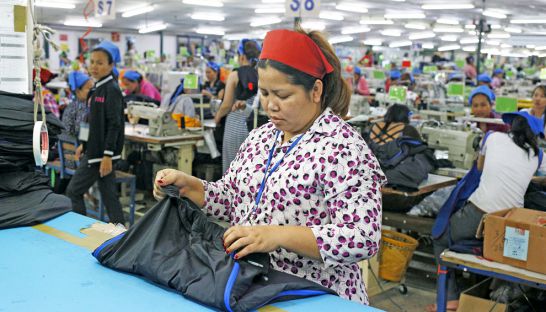Figures ‘tailored to fit agenda’
Figures ‘tailored to fit agenda’
Employer and factory owner representatives said yesterday that a steep increase in the minimum wage would affect the survival of factories in the Kingdom, given low productivity in the sector, and that any raise should not be based on figures put forward by international trade unions and organisations.

Speaking at a press conference organised by the Cambodian Federation of Employers and Business Associations (CAMFEBA), Van Sou Ieng, chairman of the Garment Manufacturers Association of Cambodia (GMAC), said trade unions were only picking up recommendations from outside organisations and basing their demands on those wage estimates.
“All the figures come from international organisations, trade unions and civil society, but none from the [local] trade unions,” he said.
“They [unions] only pick up these figures. This is ridiculous and it does not help the negotiations.”
Ieng said employers would not indulge in announcing such minimum wage figures, which was “destructive rather than constructive”, and that they would follow the process set out by the government.
“We have the formula, and the data that will be put into that formula. Some level of increase will be negotiated on the 25th of September,” he added.
“We will put those proposals to the trade unions and see if they accept the data.”
Putting forward the case of employers, Sandra D’Amico, vice president of CAMFEBA, said that while wages have been increasing over the past few years, productivity has not followed suit.
“There has not been a focus on skills and productivity building in the industry, and this is critical of the success of the development of the sector,” she said.
The value added per worker declined to an estimated $303 per month in 2014. That figure is expected to drop to $295 in 2015, putting more competitive pressure on Cambodia given that its minimum wage is higher than rivals Bangladesh, Myanmar and Vietnam.
“All the workers say you have a $7 billion industry, and we want more of this value added in the sector.
But the reality is the workers are getting more and more every year and the value added per worker is going down,” D’Amico said, adding that this was in part due to factories lowering prices to maintain competitiveness.
“Where is a factory going to survive?” she questioned. “It leaves factories unprofitable with no ability to invest in machinery, technology and skills upgrading, and that is what is going to improve productivity.”
However, Pav Sina, president of the Collective Union of Movement of Workers (CUWM), said workers were not to blame for low productivity, because factory owners have not invested in new equipment, leaving workers to operate old and outdated machinery.
“Workers have long-term experience in the garment industry and if employers complain of low productivity, it is unfair to workers, because they should be given the tools,” he said.
Apart from these technical aspects, Sina said an unhealthy worker-employee relationship was also affecting morale on the factory floor.
“The garment machines are old, and with the management’s bad attitude towards workers, how can productivity be higher? They should study this more clearly,” he added.
Sina said that employers have always accused workers of not basing their wage increase demands on sound research, using it as a pretext to avoid wage increases.
When the unions used the Labour Ministry’s 2013 minimum wage figure – between $157 and $177 per month – employers, he said, still accused them of using baseless figures.
“When we used this number to discuss wage increases, they blamed us for many reasons,” said Sina. “It is a way for employers to avoid joining the discussion table.”
With the tripartite wage negotiations ongoing, the employers are expected to put forward their minimum wage suggestion on the September 25, with a final announcement scheduled for October 1.














